Master's Thesis: Organizational Behavior Changes in O&G Mergers
VerifiedAdded on 2022/08/16
|48
|10952
|34
Thesis and Dissertation
AI Summary
This master's thesis investigates organizational behavior changes during mergers and acquisitions (M&A) within the oil and gas (O&G) industry, using the Schlumberger and Cameroon merger as a case study. The research explores the factors leading to organizational changes, including system dynamics, structure-focused changes, and person-focused changes, as well as the impact of mergers on employees, management, and company profitability. The study also examines strategies for mitigating negative impacts, such as understanding cultural differences, employee involvement, and clear communication. The methodology includes literature review, interviews, and surveys, with data analysis employing statistical methods. The findings are discussed in relation to existing literature, highlighting implications and limitations of the research. The thesis aims to provide valuable insights into managing organizational behavior during M&A in the O&G sector, contributing to the understanding of employee behavior and organizational performance during periods of significant change. The study's significance lies in addressing the limited research on the impact of M&A on the O&G industry specifically.
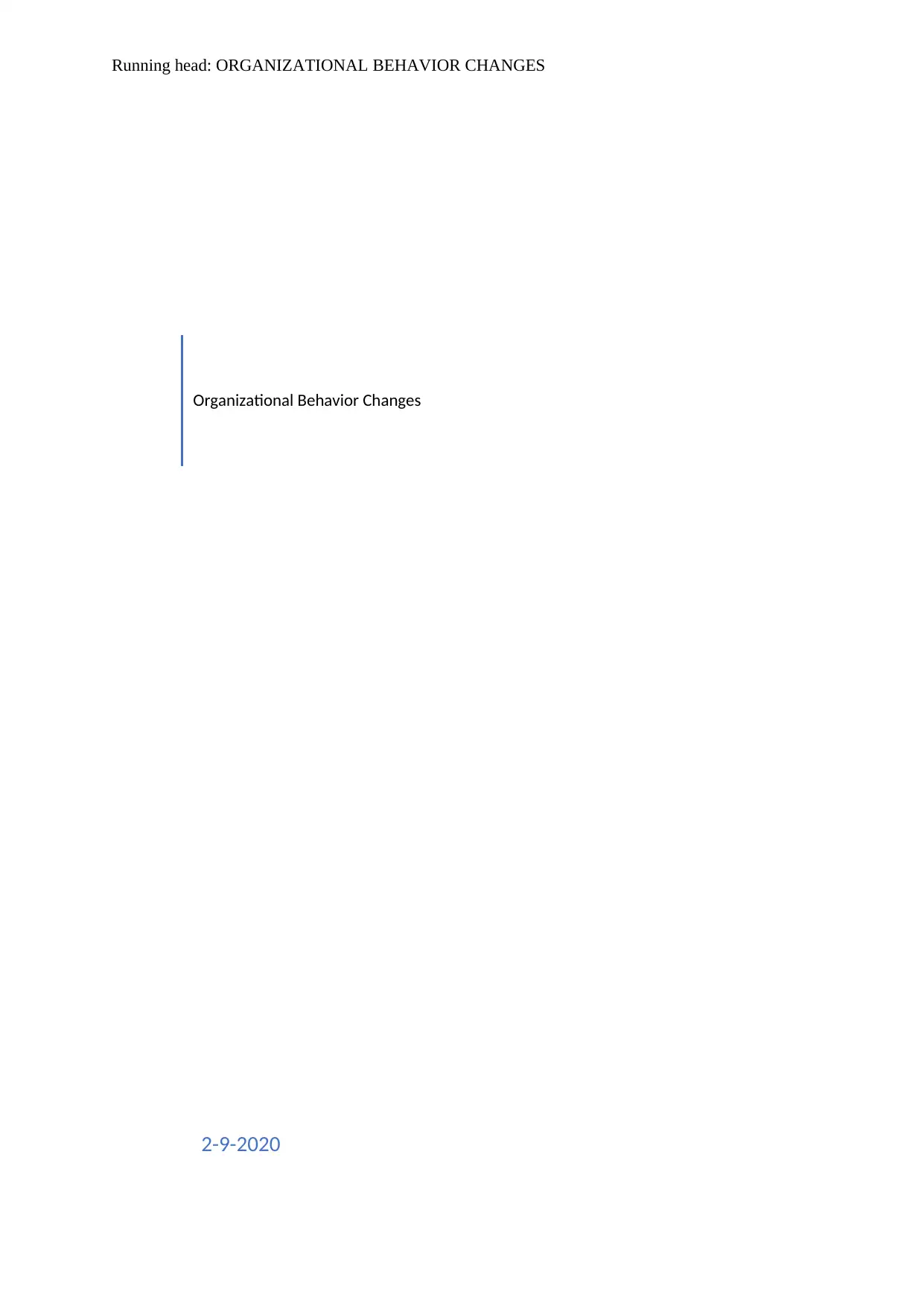
Running head: ORGANIZATIONAL BEHAVIOR CHANGES
Organizational Behavior Changes
2-9-2020
Organizational Behavior Changes
2-9-2020
Paraphrase This Document
Need a fresh take? Get an instant paraphrase of this document with our AI Paraphraser
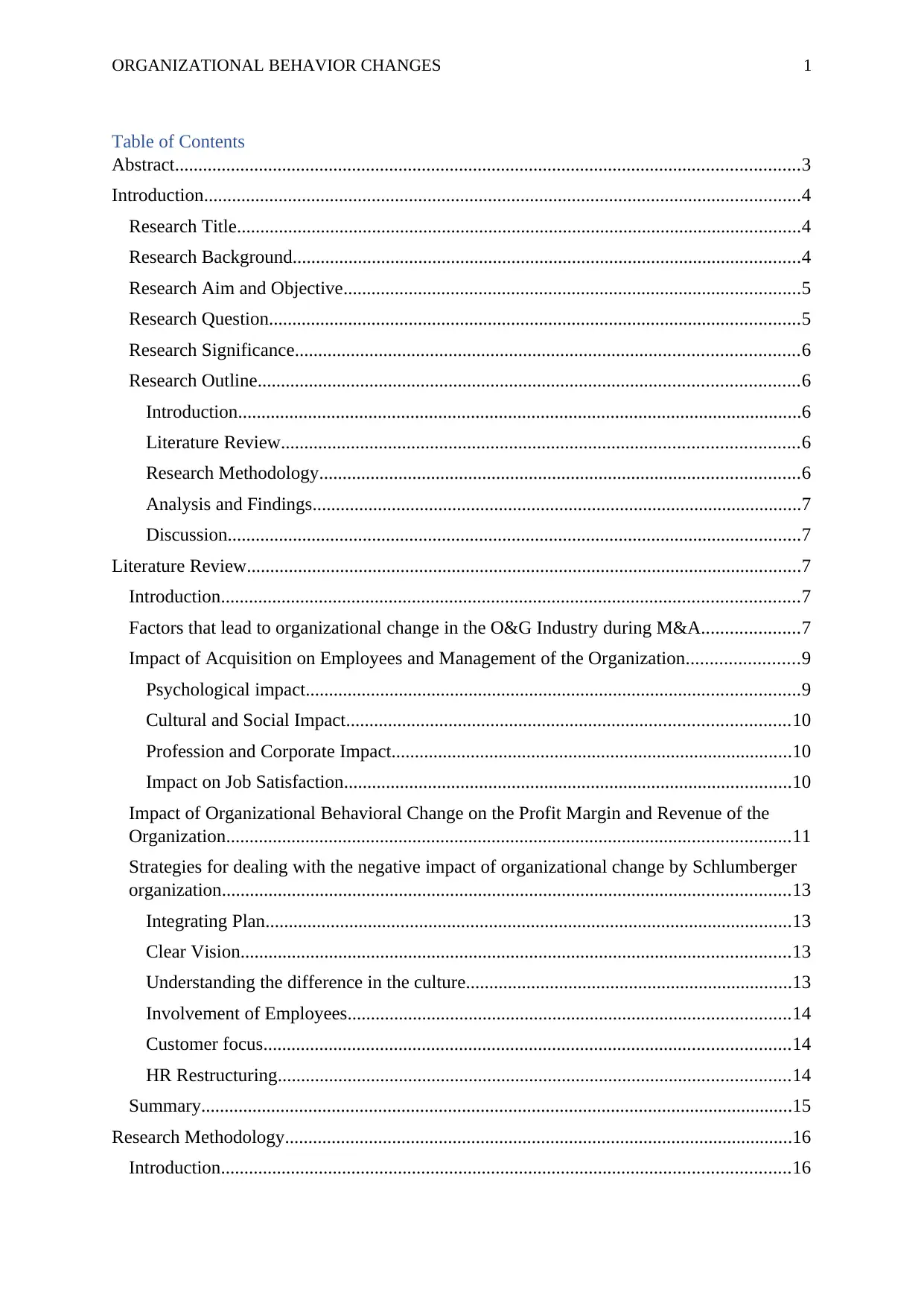
ORGANIZATIONAL BEHAVIOR CHANGES 1
Table of Contents
Abstract......................................................................................................................................3
Introduction................................................................................................................................4
Research Title.........................................................................................................................4
Research Background.............................................................................................................4
Research Aim and Objective..................................................................................................5
Research Question..................................................................................................................5
Research Significance............................................................................................................6
Research Outline....................................................................................................................6
Introduction.........................................................................................................................6
Literature Review...............................................................................................................6
Research Methodology.......................................................................................................6
Analysis and Findings.........................................................................................................7
Discussion...........................................................................................................................7
Literature Review.......................................................................................................................7
Introduction............................................................................................................................7
Factors that lead to organizational change in the O&G Industry during M&A.....................7
Impact of Acquisition on Employees and Management of the Organization........................9
Psychological impact..........................................................................................................9
Cultural and Social Impact...............................................................................................10
Profession and Corporate Impact......................................................................................10
Impact on Job Satisfaction................................................................................................10
Impact of Organizational Behavioral Change on the Profit Margin and Revenue of the
Organization.........................................................................................................................11
Strategies for dealing with the negative impact of organizational change by Schlumberger
organization..........................................................................................................................13
Integrating Plan.................................................................................................................13
Clear Vision......................................................................................................................13
Understanding the difference in the culture......................................................................13
Involvement of Employees...............................................................................................14
Customer focus.................................................................................................................14
HR Restructuring..............................................................................................................14
Summary...............................................................................................................................15
Research Methodology.............................................................................................................16
Introduction..........................................................................................................................16
Table of Contents
Abstract......................................................................................................................................3
Introduction................................................................................................................................4
Research Title.........................................................................................................................4
Research Background.............................................................................................................4
Research Aim and Objective..................................................................................................5
Research Question..................................................................................................................5
Research Significance............................................................................................................6
Research Outline....................................................................................................................6
Introduction.........................................................................................................................6
Literature Review...............................................................................................................6
Research Methodology.......................................................................................................6
Analysis and Findings.........................................................................................................7
Discussion...........................................................................................................................7
Literature Review.......................................................................................................................7
Introduction............................................................................................................................7
Factors that lead to organizational change in the O&G Industry during M&A.....................7
Impact of Acquisition on Employees and Management of the Organization........................9
Psychological impact..........................................................................................................9
Cultural and Social Impact...............................................................................................10
Profession and Corporate Impact......................................................................................10
Impact on Job Satisfaction................................................................................................10
Impact of Organizational Behavioral Change on the Profit Margin and Revenue of the
Organization.........................................................................................................................11
Strategies for dealing with the negative impact of organizational change by Schlumberger
organization..........................................................................................................................13
Integrating Plan.................................................................................................................13
Clear Vision......................................................................................................................13
Understanding the difference in the culture......................................................................13
Involvement of Employees...............................................................................................14
Customer focus.................................................................................................................14
HR Restructuring..............................................................................................................14
Summary...............................................................................................................................15
Research Methodology.............................................................................................................16
Introduction..........................................................................................................................16
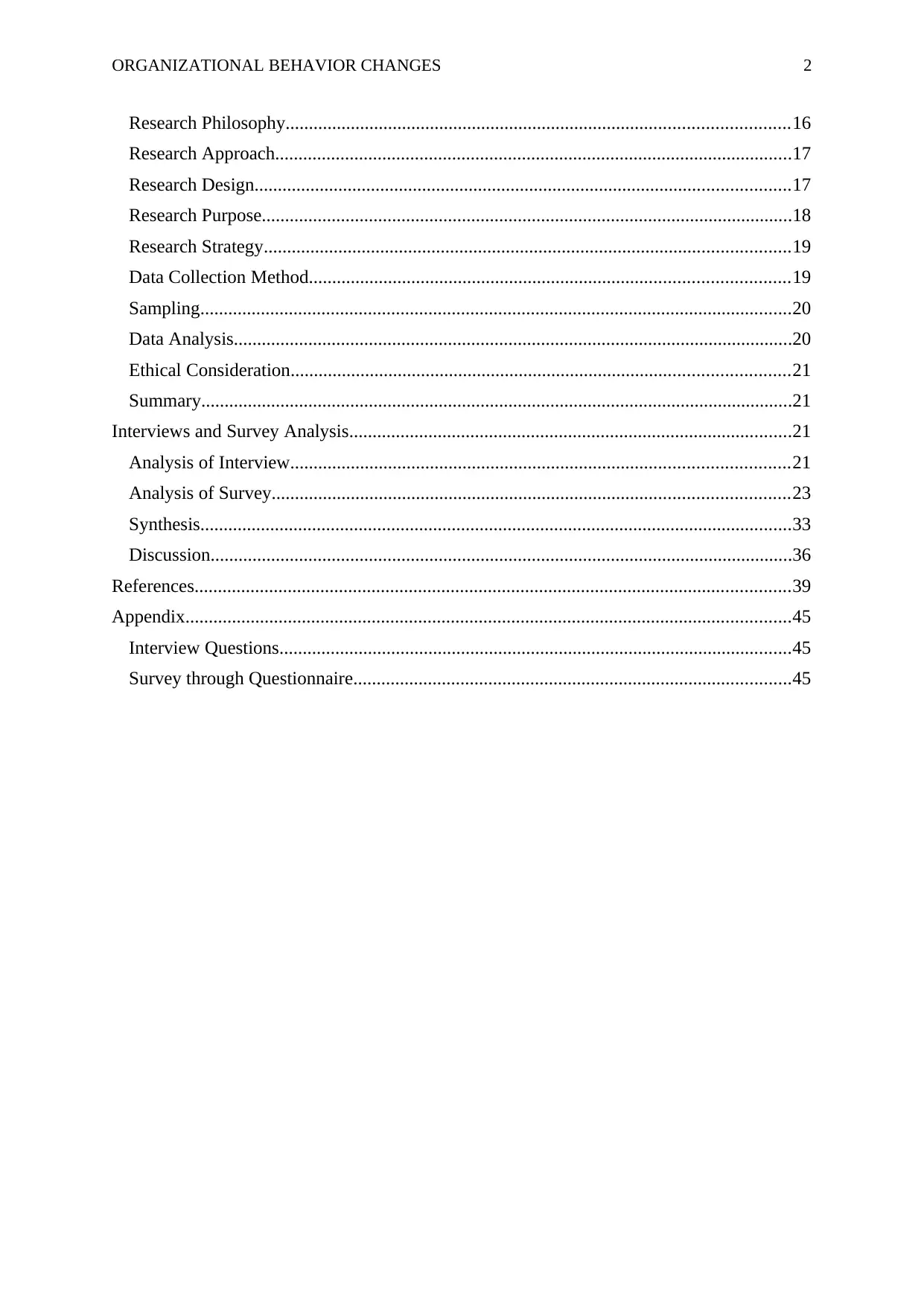
ORGANIZATIONAL BEHAVIOR CHANGES 2
Research Philosophy............................................................................................................16
Research Approach...............................................................................................................17
Research Design...................................................................................................................17
Research Purpose..................................................................................................................18
Research Strategy.................................................................................................................19
Data Collection Method.......................................................................................................19
Sampling...............................................................................................................................20
Data Analysis........................................................................................................................20
Ethical Consideration...........................................................................................................21
Summary...............................................................................................................................21
Interviews and Survey Analysis...............................................................................................21
Analysis of Interview...........................................................................................................21
Analysis of Survey...............................................................................................................23
Synthesis...............................................................................................................................33
Discussion.............................................................................................................................36
References................................................................................................................................39
Appendix..................................................................................................................................45
Interview Questions..............................................................................................................45
Survey through Questionnaire..............................................................................................45
Research Philosophy............................................................................................................16
Research Approach...............................................................................................................17
Research Design...................................................................................................................17
Research Purpose..................................................................................................................18
Research Strategy.................................................................................................................19
Data Collection Method.......................................................................................................19
Sampling...............................................................................................................................20
Data Analysis........................................................................................................................20
Ethical Consideration...........................................................................................................21
Summary...............................................................................................................................21
Interviews and Survey Analysis...............................................................................................21
Analysis of Interview...........................................................................................................21
Analysis of Survey...............................................................................................................23
Synthesis...............................................................................................................................33
Discussion.............................................................................................................................36
References................................................................................................................................39
Appendix..................................................................................................................................45
Interview Questions..............................................................................................................45
Survey through Questionnaire..............................................................................................45
⊘ This is a preview!⊘
Do you want full access?
Subscribe today to unlock all pages.

Trusted by 1+ million students worldwide
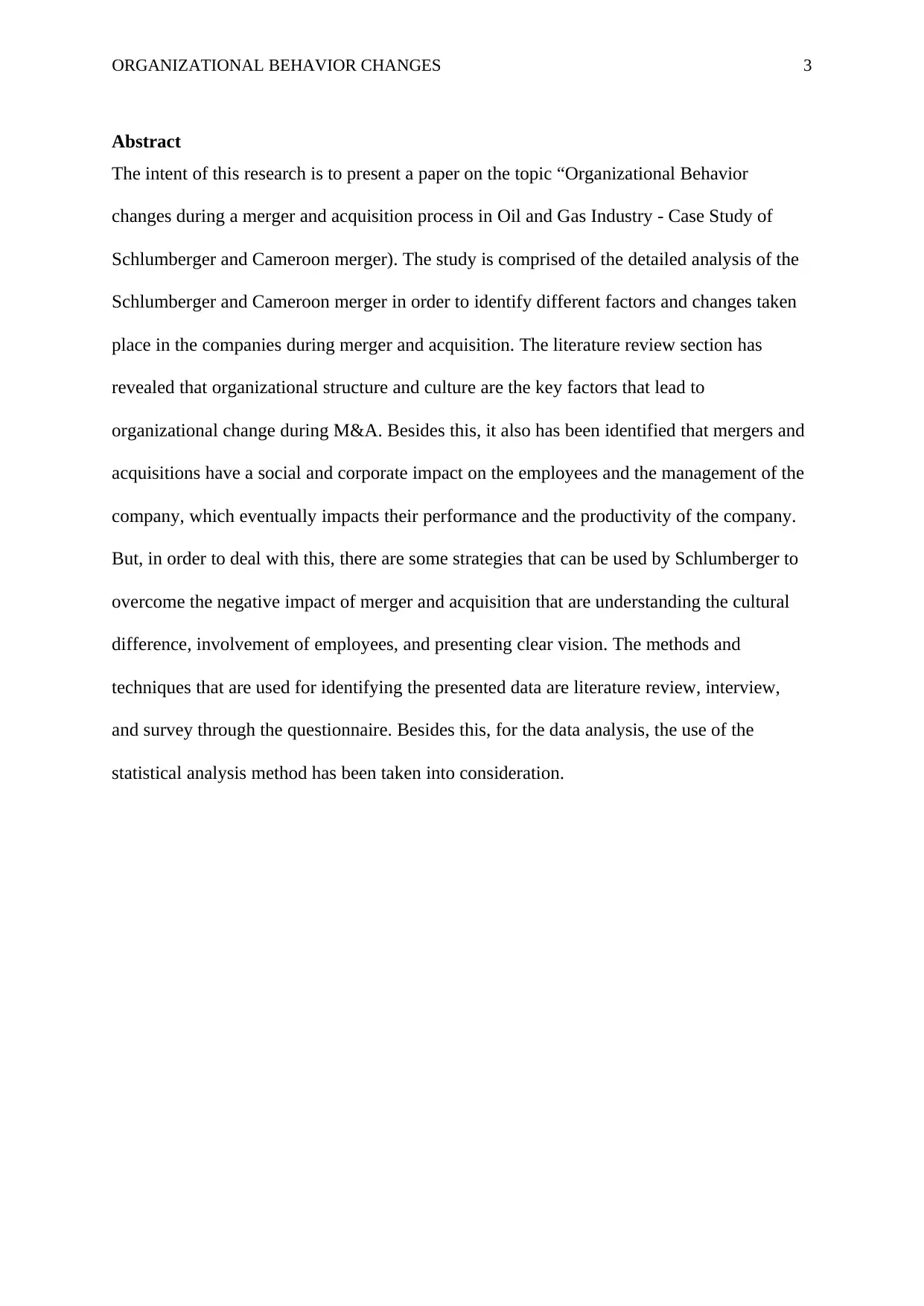
ORGANIZATIONAL BEHAVIOR CHANGES 3
Abstract
The intent of this research is to present a paper on the topic “Organizational Behavior
changes during a merger and acquisition process in Oil and Gas Industry - Case Study of
Schlumberger and Cameroon merger). The study is comprised of the detailed analysis of the
Schlumberger and Cameroon merger in order to identify different factors and changes taken
place in the companies during merger and acquisition. The literature review section has
revealed that organizational structure and culture are the key factors that lead to
organizational change during M&A. Besides this, it also has been identified that mergers and
acquisitions have a social and corporate impact on the employees and the management of the
company, which eventually impacts their performance and the productivity of the company.
But, in order to deal with this, there are some strategies that can be used by Schlumberger to
overcome the negative impact of merger and acquisition that are understanding the cultural
difference, involvement of employees, and presenting clear vision. The methods and
techniques that are used for identifying the presented data are literature review, interview,
and survey through the questionnaire. Besides this, for the data analysis, the use of the
statistical analysis method has been taken into consideration.
Abstract
The intent of this research is to present a paper on the topic “Organizational Behavior
changes during a merger and acquisition process in Oil and Gas Industry - Case Study of
Schlumberger and Cameroon merger). The study is comprised of the detailed analysis of the
Schlumberger and Cameroon merger in order to identify different factors and changes taken
place in the companies during merger and acquisition. The literature review section has
revealed that organizational structure and culture are the key factors that lead to
organizational change during M&A. Besides this, it also has been identified that mergers and
acquisitions have a social and corporate impact on the employees and the management of the
company, which eventually impacts their performance and the productivity of the company.
But, in order to deal with this, there are some strategies that can be used by Schlumberger to
overcome the negative impact of merger and acquisition that are understanding the cultural
difference, involvement of employees, and presenting clear vision. The methods and
techniques that are used for identifying the presented data are literature review, interview,
and survey through the questionnaire. Besides this, for the data analysis, the use of the
statistical analysis method has been taken into consideration.
Paraphrase This Document
Need a fresh take? Get an instant paraphrase of this document with our AI Paraphraser
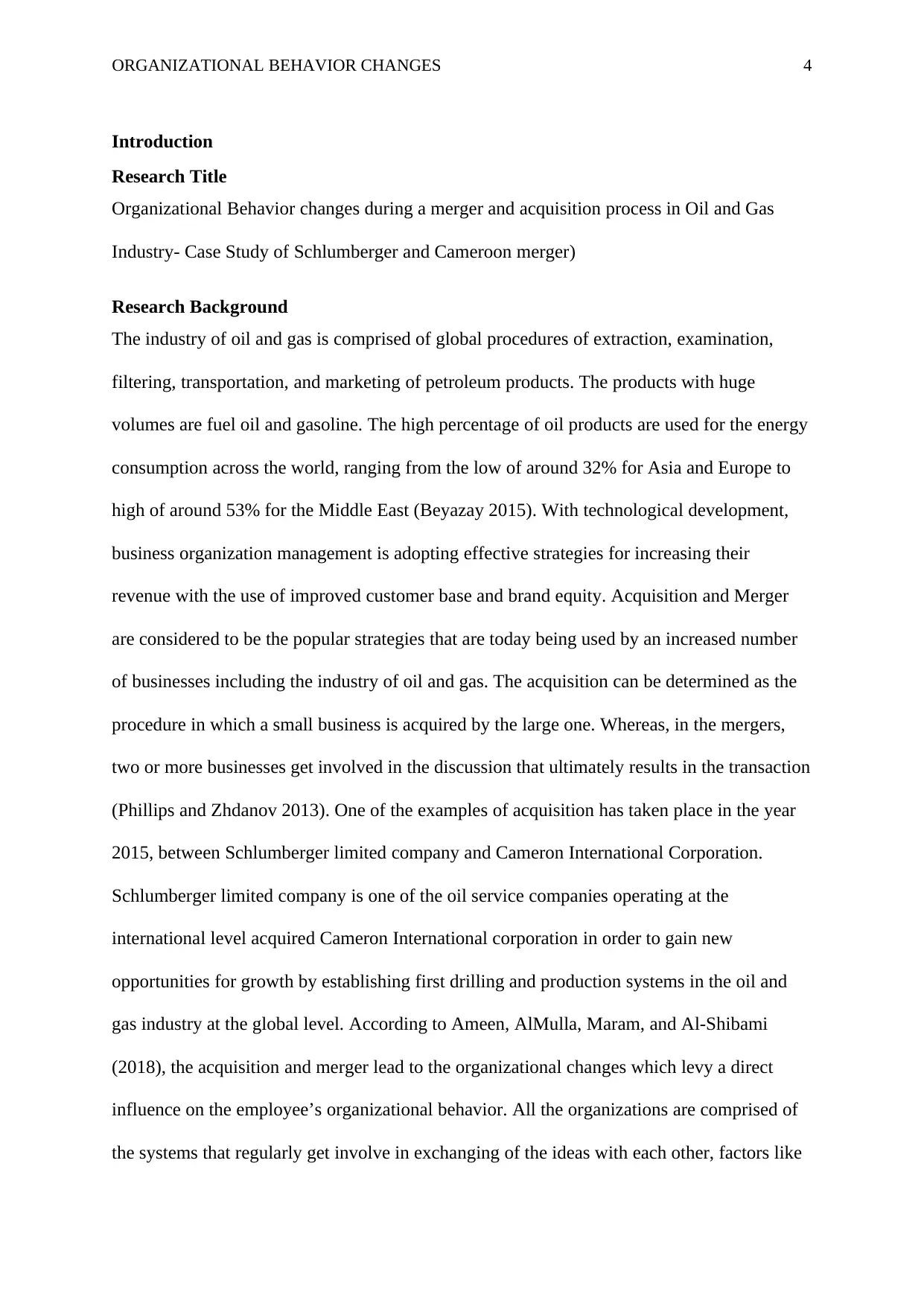
ORGANIZATIONAL BEHAVIOR CHANGES 4
Introduction
Research Title
Organizational Behavior changes during a merger and acquisition process in Oil and Gas
Industry- Case Study of Schlumberger and Cameroon merger)
Research Background
The industry of oil and gas is comprised of global procedures of extraction, examination,
filtering, transportation, and marketing of petroleum products. The products with huge
volumes are fuel oil and gasoline. The high percentage of oil products are used for the energy
consumption across the world, ranging from the low of around 32% for Asia and Europe to
high of around 53% for the Middle East (Beyazay 2015). With technological development,
business organization management is adopting effective strategies for increasing their
revenue with the use of improved customer base and brand equity. Acquisition and Merger
are considered to be the popular strategies that are today being used by an increased number
of businesses including the industry of oil and gas. The acquisition can be determined as the
procedure in which a small business is acquired by the large one. Whereas, in the mergers,
two or more businesses get involved in the discussion that ultimately results in the transaction
(Phillips and Zhdanov 2013). One of the examples of acquisition has taken place in the year
2015, between Schlumberger limited company and Cameron International Corporation.
Schlumberger limited company is one of the oil service companies operating at the
international level acquired Cameron International corporation in order to gain new
opportunities for growth by establishing first drilling and production systems in the oil and
gas industry at the global level. According to Ameen, AlMulla, Maram, and Al-Shibami
(2018), the acquisition and merger lead to the organizational changes which levy a direct
influence on the employee’s organizational behavior. All the organizations are comprised of
the systems that regularly get involve in exchanging of the ideas with each other, factors like
Introduction
Research Title
Organizational Behavior changes during a merger and acquisition process in Oil and Gas
Industry- Case Study of Schlumberger and Cameroon merger)
Research Background
The industry of oil and gas is comprised of global procedures of extraction, examination,
filtering, transportation, and marketing of petroleum products. The products with huge
volumes are fuel oil and gasoline. The high percentage of oil products are used for the energy
consumption across the world, ranging from the low of around 32% for Asia and Europe to
high of around 53% for the Middle East (Beyazay 2015). With technological development,
business organization management is adopting effective strategies for increasing their
revenue with the use of improved customer base and brand equity. Acquisition and Merger
are considered to be the popular strategies that are today being used by an increased number
of businesses including the industry of oil and gas. The acquisition can be determined as the
procedure in which a small business is acquired by the large one. Whereas, in the mergers,
two or more businesses get involved in the discussion that ultimately results in the transaction
(Phillips and Zhdanov 2013). One of the examples of acquisition has taken place in the year
2015, between Schlumberger limited company and Cameron International Corporation.
Schlumberger limited company is one of the oil service companies operating at the
international level acquired Cameron International corporation in order to gain new
opportunities for growth by establishing first drilling and production systems in the oil and
gas industry at the global level. According to Ameen, AlMulla, Maram, and Al-Shibami
(2018), the acquisition and merger lead to the organizational changes which levy a direct
influence on the employee’s organizational behavior. All the organizations are comprised of
the systems that regularly get involve in exchanging of the ideas with each other, factors like
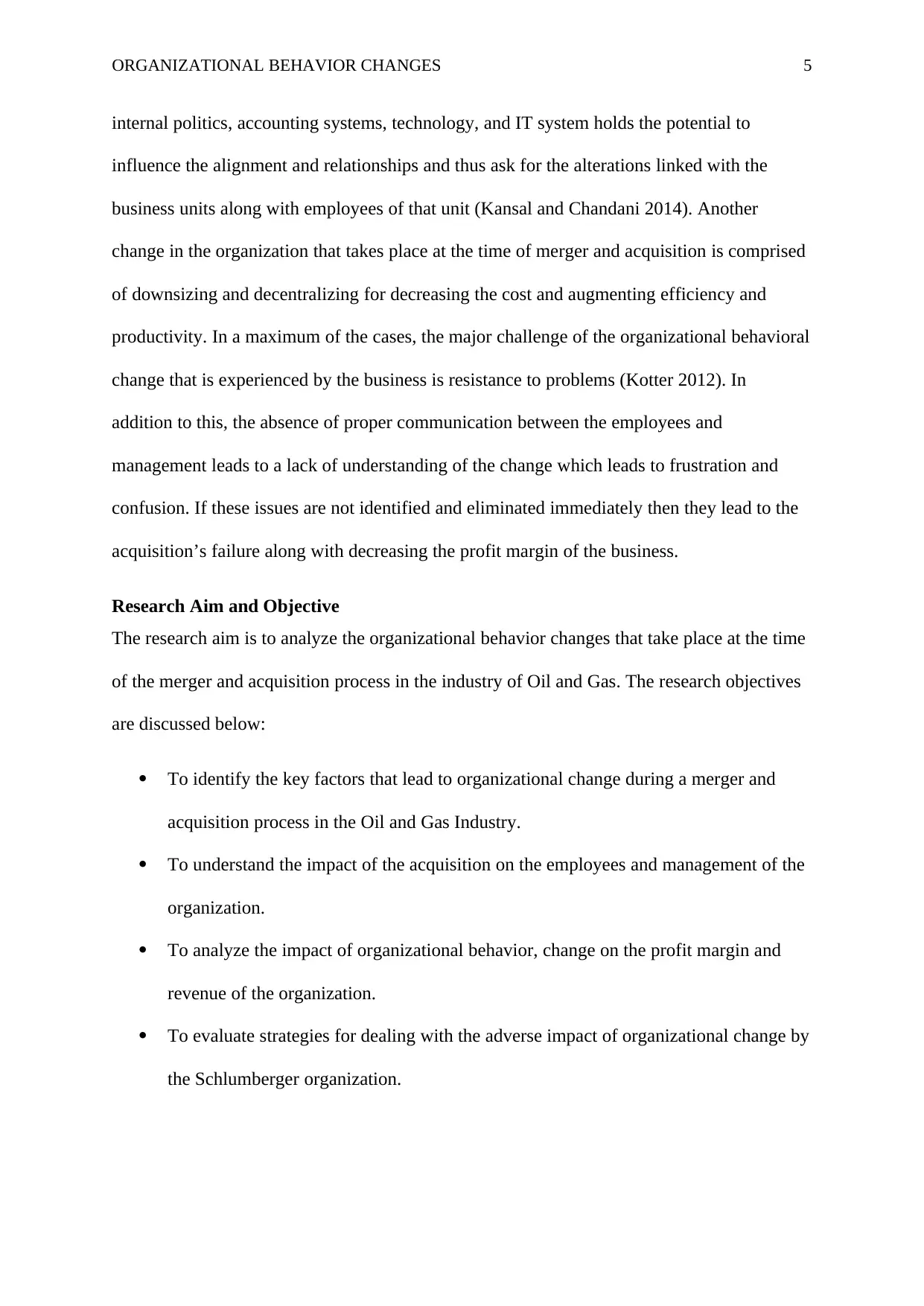
ORGANIZATIONAL BEHAVIOR CHANGES 5
internal politics, accounting systems, technology, and IT system holds the potential to
influence the alignment and relationships and thus ask for the alterations linked with the
business units along with employees of that unit (Kansal and Chandani 2014). Another
change in the organization that takes place at the time of merger and acquisition is comprised
of downsizing and decentralizing for decreasing the cost and augmenting efficiency and
productivity. In a maximum of the cases, the major challenge of the organizational behavioral
change that is experienced by the business is resistance to problems (Kotter 2012). In
addition to this, the absence of proper communication between the employees and
management leads to a lack of understanding of the change which leads to frustration and
confusion. If these issues are not identified and eliminated immediately then they lead to the
acquisition’s failure along with decreasing the profit margin of the business.
Research Aim and Objective
The research aim is to analyze the organizational behavior changes that take place at the time
of the merger and acquisition process in the industry of Oil and Gas. The research objectives
are discussed below:
To identify the key factors that lead to organizational change during a merger and
acquisition process in the Oil and Gas Industry.
To understand the impact of the acquisition on the employees and management of the
organization.
To analyze the impact of organizational behavior, change on the profit margin and
revenue of the organization.
To evaluate strategies for dealing with the adverse impact of organizational change by
the Schlumberger organization.
internal politics, accounting systems, technology, and IT system holds the potential to
influence the alignment and relationships and thus ask for the alterations linked with the
business units along with employees of that unit (Kansal and Chandani 2014). Another
change in the organization that takes place at the time of merger and acquisition is comprised
of downsizing and decentralizing for decreasing the cost and augmenting efficiency and
productivity. In a maximum of the cases, the major challenge of the organizational behavioral
change that is experienced by the business is resistance to problems (Kotter 2012). In
addition to this, the absence of proper communication between the employees and
management leads to a lack of understanding of the change which leads to frustration and
confusion. If these issues are not identified and eliminated immediately then they lead to the
acquisition’s failure along with decreasing the profit margin of the business.
Research Aim and Objective
The research aim is to analyze the organizational behavior changes that take place at the time
of the merger and acquisition process in the industry of Oil and Gas. The research objectives
are discussed below:
To identify the key factors that lead to organizational change during a merger and
acquisition process in the Oil and Gas Industry.
To understand the impact of the acquisition on the employees and management of the
organization.
To analyze the impact of organizational behavior, change on the profit margin and
revenue of the organization.
To evaluate strategies for dealing with the adverse impact of organizational change by
the Schlumberger organization.
⊘ This is a preview!⊘
Do you want full access?
Subscribe today to unlock all pages.

Trusted by 1+ million students worldwide
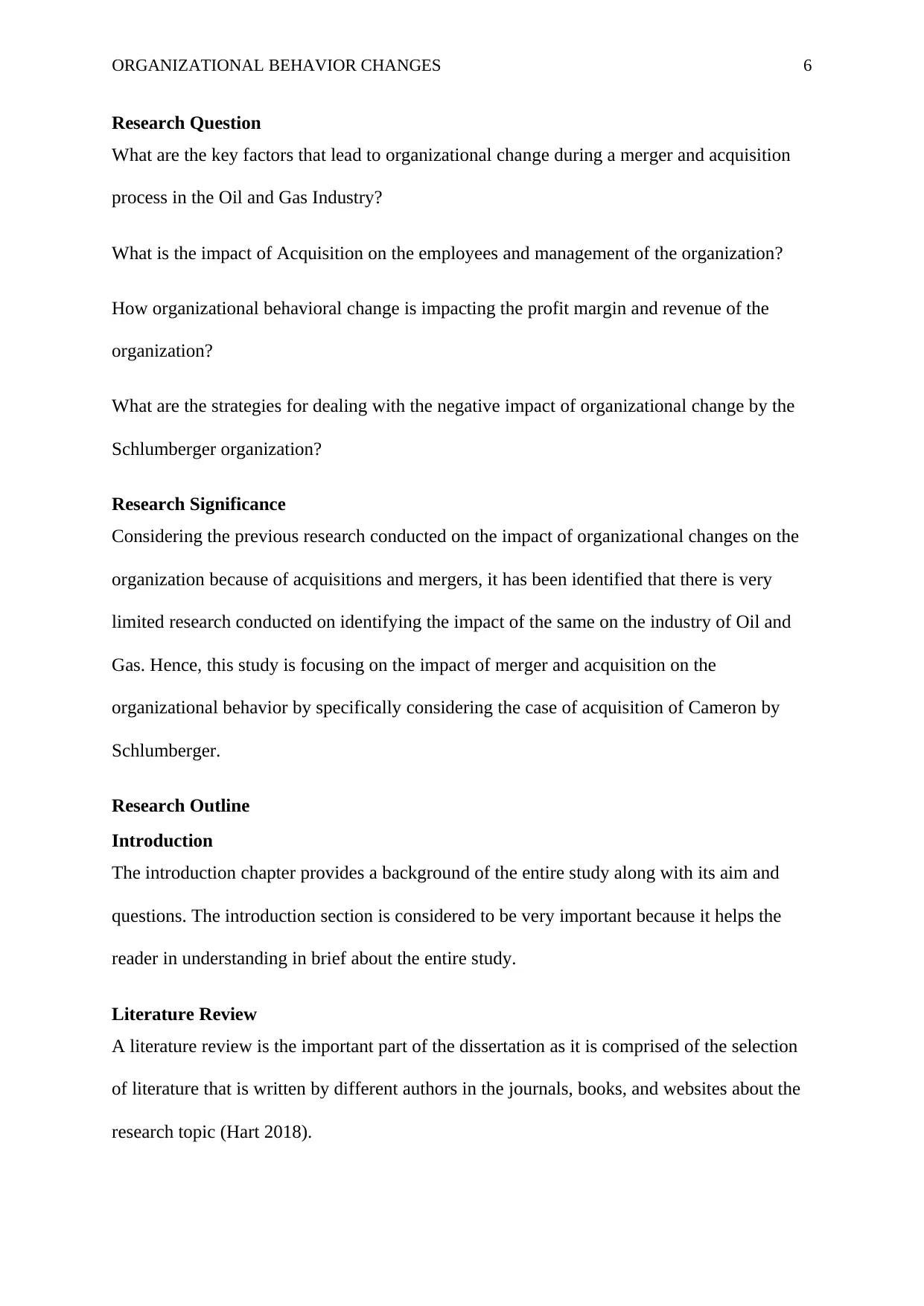
ORGANIZATIONAL BEHAVIOR CHANGES 6
Research Question
What are the key factors that lead to organizational change during a merger and acquisition
process in the Oil and Gas Industry?
What is the impact of Acquisition on the employees and management of the organization?
How organizational behavioral change is impacting the profit margin and revenue of the
organization?
What are the strategies for dealing with the negative impact of organizational change by the
Schlumberger organization?
Research Significance
Considering the previous research conducted on the impact of organizational changes on the
organization because of acquisitions and mergers, it has been identified that there is very
limited research conducted on identifying the impact of the same on the industry of Oil and
Gas. Hence, this study is focusing on the impact of merger and acquisition on the
organizational behavior by specifically considering the case of acquisition of Cameron by
Schlumberger.
Research Outline
Introduction
The introduction chapter provides a background of the entire study along with its aim and
questions. The introduction section is considered to be very important because it helps the
reader in understanding in brief about the entire study.
Literature Review
A literature review is the important part of the dissertation as it is comprised of the selection
of literature that is written by different authors in the journals, books, and websites about the
research topic (Hart 2018).
Research Question
What are the key factors that lead to organizational change during a merger and acquisition
process in the Oil and Gas Industry?
What is the impact of Acquisition on the employees and management of the organization?
How organizational behavioral change is impacting the profit margin and revenue of the
organization?
What are the strategies for dealing with the negative impact of organizational change by the
Schlumberger organization?
Research Significance
Considering the previous research conducted on the impact of organizational changes on the
organization because of acquisitions and mergers, it has been identified that there is very
limited research conducted on identifying the impact of the same on the industry of Oil and
Gas. Hence, this study is focusing on the impact of merger and acquisition on the
organizational behavior by specifically considering the case of acquisition of Cameron by
Schlumberger.
Research Outline
Introduction
The introduction chapter provides a background of the entire study along with its aim and
questions. The introduction section is considered to be very important because it helps the
reader in understanding in brief about the entire study.
Literature Review
A literature review is the important part of the dissertation as it is comprised of the selection
of literature that is written by different authors in the journals, books, and websites about the
research topic (Hart 2018).
Paraphrase This Document
Need a fresh take? Get an instant paraphrase of this document with our AI Paraphraser
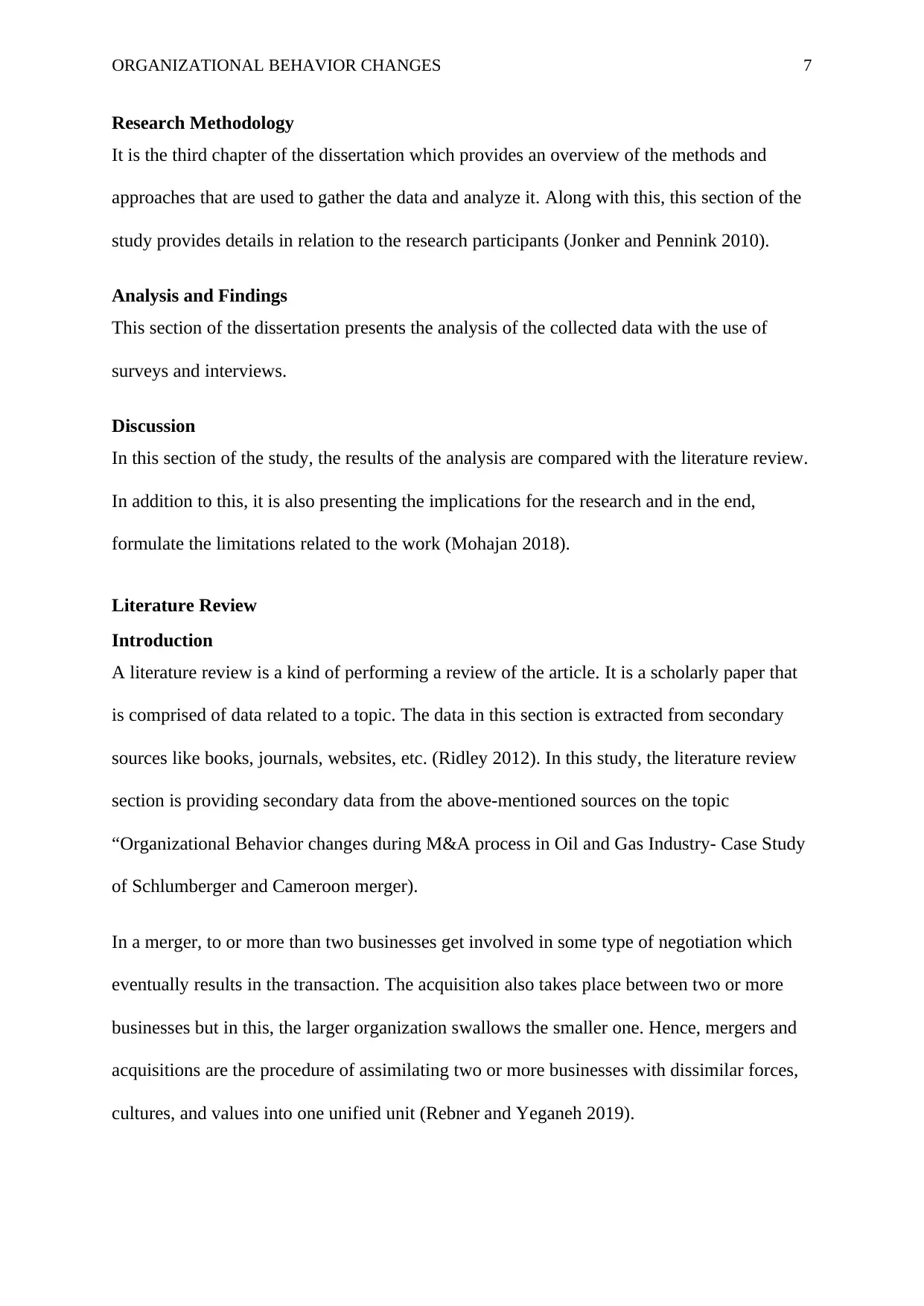
ORGANIZATIONAL BEHAVIOR CHANGES 7
Research Methodology
It is the third chapter of the dissertation which provides an overview of the methods and
approaches that are used to gather the data and analyze it. Along with this, this section of the
study provides details in relation to the research participants (Jonker and Pennink 2010).
Analysis and Findings
This section of the dissertation presents the analysis of the collected data with the use of
surveys and interviews.
Discussion
In this section of the study, the results of the analysis are compared with the literature review.
In addition to this, it is also presenting the implications for the research and in the end,
formulate the limitations related to the work (Mohajan 2018).
Literature Review
Introduction
A literature review is a kind of performing a review of the article. It is a scholarly paper that
is comprised of data related to a topic. The data in this section is extracted from secondary
sources like books, journals, websites, etc. (Ridley 2012). In this study, the literature review
section is providing secondary data from the above-mentioned sources on the topic
“Organizational Behavior changes during M&A process in Oil and Gas Industry- Case Study
of Schlumberger and Cameroon merger).
In a merger, to or more than two businesses get involved in some type of negotiation which
eventually results in the transaction. The acquisition also takes place between two or more
businesses but in this, the larger organization swallows the smaller one. Hence, mergers and
acquisitions are the procedure of assimilating two or more businesses with dissimilar forces,
cultures, and values into one unified unit (Rebner and Yeganeh 2019).
Research Methodology
It is the third chapter of the dissertation which provides an overview of the methods and
approaches that are used to gather the data and analyze it. Along with this, this section of the
study provides details in relation to the research participants (Jonker and Pennink 2010).
Analysis and Findings
This section of the dissertation presents the analysis of the collected data with the use of
surveys and interviews.
Discussion
In this section of the study, the results of the analysis are compared with the literature review.
In addition to this, it is also presenting the implications for the research and in the end,
formulate the limitations related to the work (Mohajan 2018).
Literature Review
Introduction
A literature review is a kind of performing a review of the article. It is a scholarly paper that
is comprised of data related to a topic. The data in this section is extracted from secondary
sources like books, journals, websites, etc. (Ridley 2012). In this study, the literature review
section is providing secondary data from the above-mentioned sources on the topic
“Organizational Behavior changes during M&A process in Oil and Gas Industry- Case Study
of Schlumberger and Cameroon merger).
In a merger, to or more than two businesses get involved in some type of negotiation which
eventually results in the transaction. The acquisition also takes place between two or more
businesses but in this, the larger organization swallows the smaller one. Hence, mergers and
acquisitions are the procedure of assimilating two or more businesses with dissimilar forces,
cultures, and values into one unified unit (Rebner and Yeganeh 2019).
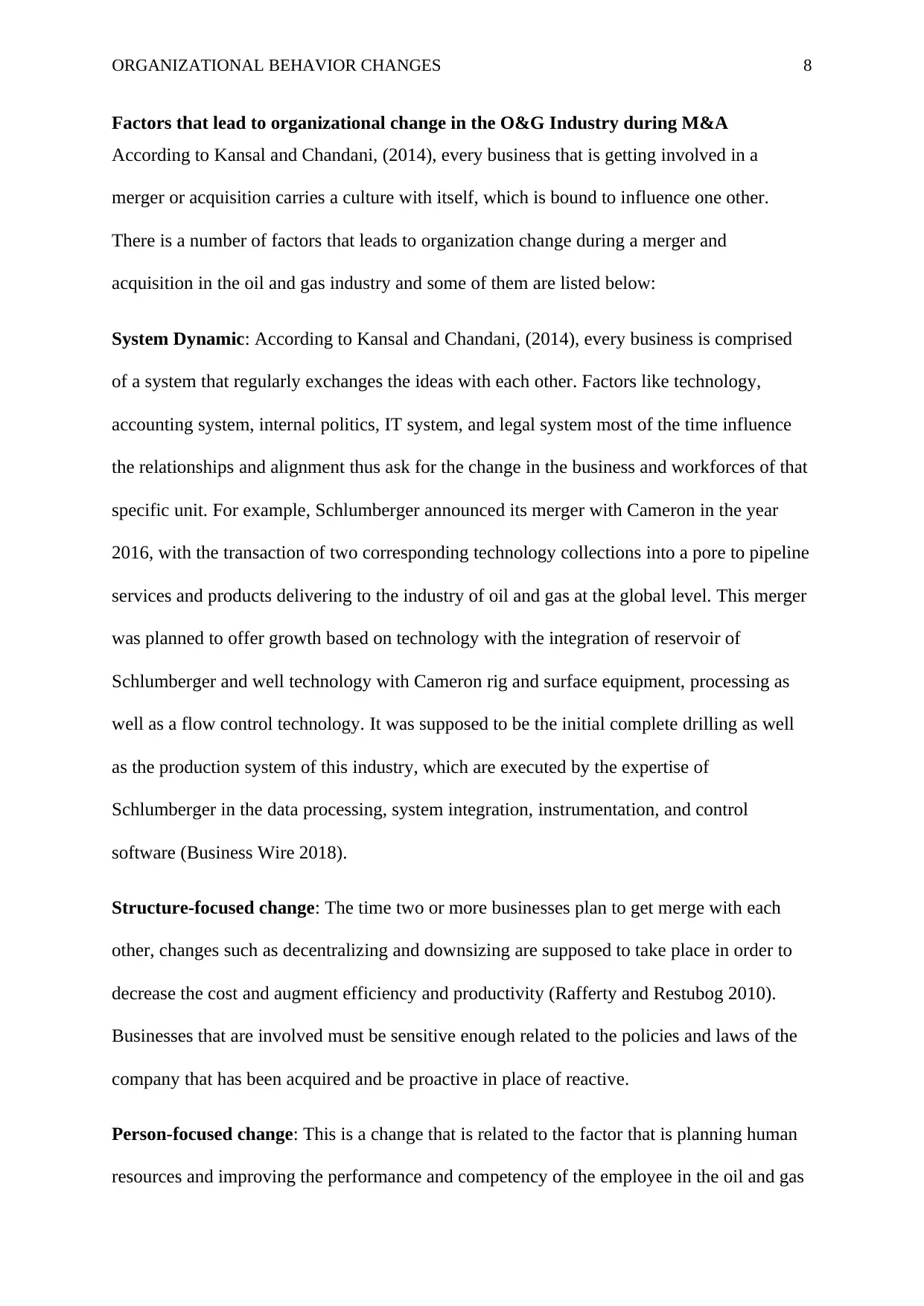
ORGANIZATIONAL BEHAVIOR CHANGES 8
Factors that lead to organizational change in the O&G Industry during M&A
According to Kansal and Chandani, (2014), every business that is getting involved in a
merger or acquisition carries a culture with itself, which is bound to influence one other.
There is a number of factors that leads to organization change during a merger and
acquisition in the oil and gas industry and some of them are listed below:
System Dynamic: According to Kansal and Chandani, (2014), every business is comprised
of a system that regularly exchanges the ideas with each other. Factors like technology,
accounting system, internal politics, IT system, and legal system most of the time influence
the relationships and alignment thus ask for the change in the business and workforces of that
specific unit. For example, Schlumberger announced its merger with Cameron in the year
2016, with the transaction of two corresponding technology collections into a pore to pipeline
services and products delivering to the industry of oil and gas at the global level. This merger
was planned to offer growth based on technology with the integration of reservoir of
Schlumberger and well technology with Cameron rig and surface equipment, processing as
well as a flow control technology. It was supposed to be the initial complete drilling as well
as the production system of this industry, which are executed by the expertise of
Schlumberger in the data processing, system integration, instrumentation, and control
software (Business Wire 2018).
Structure-focused change: The time two or more businesses plan to get merge with each
other, changes such as decentralizing and downsizing are supposed to take place in order to
decrease the cost and augment efficiency and productivity (Rafferty and Restubog 2010).
Businesses that are involved must be sensitive enough related to the policies and laws of the
company that has been acquired and be proactive in place of reactive.
Person-focused change: This is a change that is related to the factor that is planning human
resources and improving the performance and competency of the employee in the oil and gas
Factors that lead to organizational change in the O&G Industry during M&A
According to Kansal and Chandani, (2014), every business that is getting involved in a
merger or acquisition carries a culture with itself, which is bound to influence one other.
There is a number of factors that leads to organization change during a merger and
acquisition in the oil and gas industry and some of them are listed below:
System Dynamic: According to Kansal and Chandani, (2014), every business is comprised
of a system that regularly exchanges the ideas with each other. Factors like technology,
accounting system, internal politics, IT system, and legal system most of the time influence
the relationships and alignment thus ask for the change in the business and workforces of that
specific unit. For example, Schlumberger announced its merger with Cameron in the year
2016, with the transaction of two corresponding technology collections into a pore to pipeline
services and products delivering to the industry of oil and gas at the global level. This merger
was planned to offer growth based on technology with the integration of reservoir of
Schlumberger and well technology with Cameron rig and surface equipment, processing as
well as a flow control technology. It was supposed to be the initial complete drilling as well
as the production system of this industry, which are executed by the expertise of
Schlumberger in the data processing, system integration, instrumentation, and control
software (Business Wire 2018).
Structure-focused change: The time two or more businesses plan to get merge with each
other, changes such as decentralizing and downsizing are supposed to take place in order to
decrease the cost and augment efficiency and productivity (Rafferty and Restubog 2010).
Businesses that are involved must be sensitive enough related to the policies and laws of the
company that has been acquired and be proactive in place of reactive.
Person-focused change: This is a change that is related to the factor that is planning human
resources and improving the performance and competency of the employee in the oil and gas
⊘ This is a preview!⊘
Do you want full access?
Subscribe today to unlock all pages.

Trusted by 1+ million students worldwide
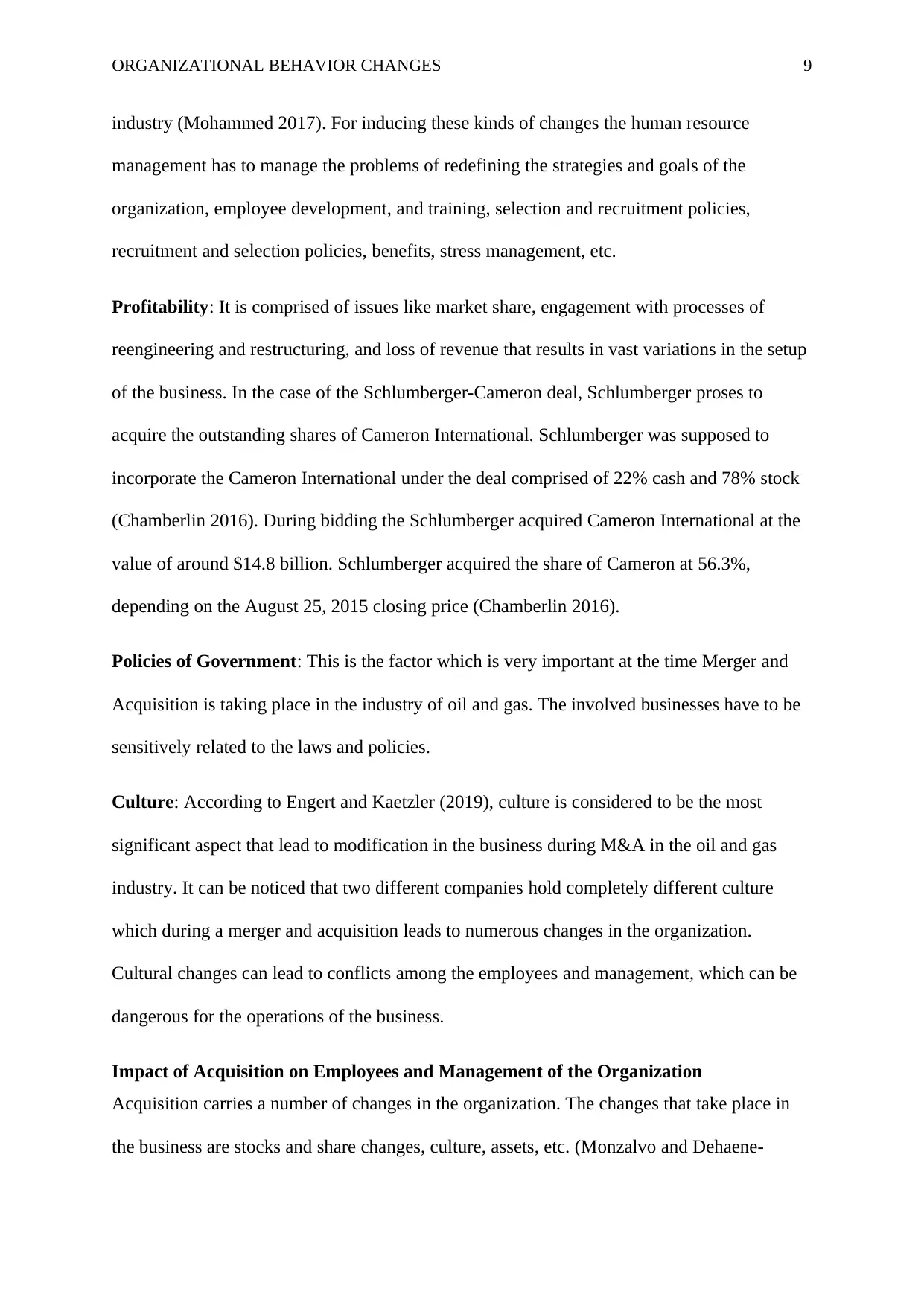
ORGANIZATIONAL BEHAVIOR CHANGES 9
industry (Mohammed 2017). For inducing these kinds of changes the human resource
management has to manage the problems of redefining the strategies and goals of the
organization, employee development, and training, selection and recruitment policies,
recruitment and selection policies, benefits, stress management, etc.
Profitability: It is comprised of issues like market share, engagement with processes of
reengineering and restructuring, and loss of revenue that results in vast variations in the setup
of the business. In the case of the Schlumberger-Cameron deal, Schlumberger proses to
acquire the outstanding shares of Cameron International. Schlumberger was supposed to
incorporate the Cameron International under the deal comprised of 22% cash and 78% stock
(Chamberlin 2016). During bidding the Schlumberger acquired Cameron International at the
value of around $14.8 billion. Schlumberger acquired the share of Cameron at 56.3%,
depending on the August 25, 2015 closing price (Chamberlin 2016).
Policies of Government: This is the factor which is very important at the time Merger and
Acquisition is taking place in the industry of oil and gas. The involved businesses have to be
sensitively related to the laws and policies.
Culture: According to Engert and Kaetzler (2019), culture is considered to be the most
significant aspect that lead to modification in the business during M&A in the oil and gas
industry. It can be noticed that two different companies hold completely different culture
which during a merger and acquisition leads to numerous changes in the organization.
Cultural changes can lead to conflicts among the employees and management, which can be
dangerous for the operations of the business.
Impact of Acquisition on Employees and Management of the Organization
Acquisition carries a number of changes in the organization. The changes that take place in
the business are stocks and share changes, culture, assets, etc. (Monzalvo and Dehaene-
industry (Mohammed 2017). For inducing these kinds of changes the human resource
management has to manage the problems of redefining the strategies and goals of the
organization, employee development, and training, selection and recruitment policies,
recruitment and selection policies, benefits, stress management, etc.
Profitability: It is comprised of issues like market share, engagement with processes of
reengineering and restructuring, and loss of revenue that results in vast variations in the setup
of the business. In the case of the Schlumberger-Cameron deal, Schlumberger proses to
acquire the outstanding shares of Cameron International. Schlumberger was supposed to
incorporate the Cameron International under the deal comprised of 22% cash and 78% stock
(Chamberlin 2016). During bidding the Schlumberger acquired Cameron International at the
value of around $14.8 billion. Schlumberger acquired the share of Cameron at 56.3%,
depending on the August 25, 2015 closing price (Chamberlin 2016).
Policies of Government: This is the factor which is very important at the time Merger and
Acquisition is taking place in the industry of oil and gas. The involved businesses have to be
sensitively related to the laws and policies.
Culture: According to Engert and Kaetzler (2019), culture is considered to be the most
significant aspect that lead to modification in the business during M&A in the oil and gas
industry. It can be noticed that two different companies hold completely different culture
which during a merger and acquisition leads to numerous changes in the organization.
Cultural changes can lead to conflicts among the employees and management, which can be
dangerous for the operations of the business.
Impact of Acquisition on Employees and Management of the Organization
Acquisition carries a number of changes in the organization. The changes that take place in
the business are stocks and share changes, culture, assets, etc. (Monzalvo and Dehaene-
Paraphrase This Document
Need a fresh take? Get an instant paraphrase of this document with our AI Paraphraser
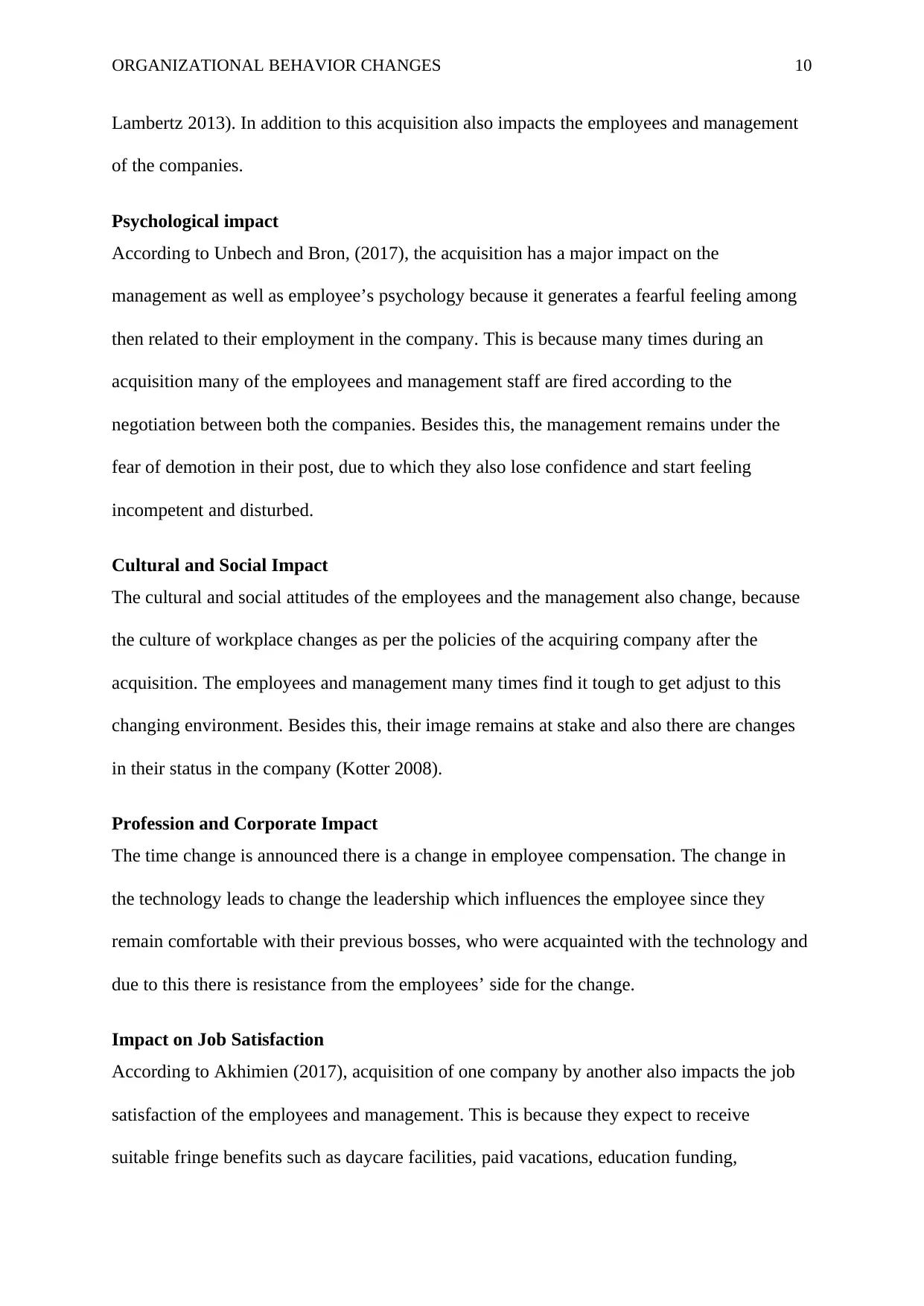
ORGANIZATIONAL BEHAVIOR CHANGES 10
Lambertz 2013). In addition to this acquisition also impacts the employees and management
of the companies.
Psychological impact
According to Unbech and Bron, (2017), the acquisition has a major impact on the
management as well as employee’s psychology because it generates a fearful feeling among
then related to their employment in the company. This is because many times during an
acquisition many of the employees and management staff are fired according to the
negotiation between both the companies. Besides this, the management remains under the
fear of demotion in their post, due to which they also lose confidence and start feeling
incompetent and disturbed.
Cultural and Social Impact
The cultural and social attitudes of the employees and the management also change, because
the culture of workplace changes as per the policies of the acquiring company after the
acquisition. The employees and management many times find it tough to get adjust to this
changing environment. Besides this, their image remains at stake and also there are changes
in their status in the company (Kotter 2008).
Profession and Corporate Impact
The time change is announced there is a change in employee compensation. The change in
the technology leads to change the leadership which influences the employee since they
remain comfortable with their previous bosses, who were acquainted with the technology and
due to this there is resistance from the employees’ side for the change.
Impact on Job Satisfaction
According to Akhimien (2017), acquisition of one company by another also impacts the job
satisfaction of the employees and management. This is because they expect to receive
suitable fringe benefits such as daycare facilities, paid vacations, education funding,
Lambertz 2013). In addition to this acquisition also impacts the employees and management
of the companies.
Psychological impact
According to Unbech and Bron, (2017), the acquisition has a major impact on the
management as well as employee’s psychology because it generates a fearful feeling among
then related to their employment in the company. This is because many times during an
acquisition many of the employees and management staff are fired according to the
negotiation between both the companies. Besides this, the management remains under the
fear of demotion in their post, due to which they also lose confidence and start feeling
incompetent and disturbed.
Cultural and Social Impact
The cultural and social attitudes of the employees and the management also change, because
the culture of workplace changes as per the policies of the acquiring company after the
acquisition. The employees and management many times find it tough to get adjust to this
changing environment. Besides this, their image remains at stake and also there are changes
in their status in the company (Kotter 2008).
Profession and Corporate Impact
The time change is announced there is a change in employee compensation. The change in
the technology leads to change the leadership which influences the employee since they
remain comfortable with their previous bosses, who were acquainted with the technology and
due to this there is resistance from the employees’ side for the change.
Impact on Job Satisfaction
According to Akhimien (2017), acquisition of one company by another also impacts the job
satisfaction of the employees and management. This is because they expect to receive
suitable fringe benefits such as daycare facilities, paid vacations, education funding,
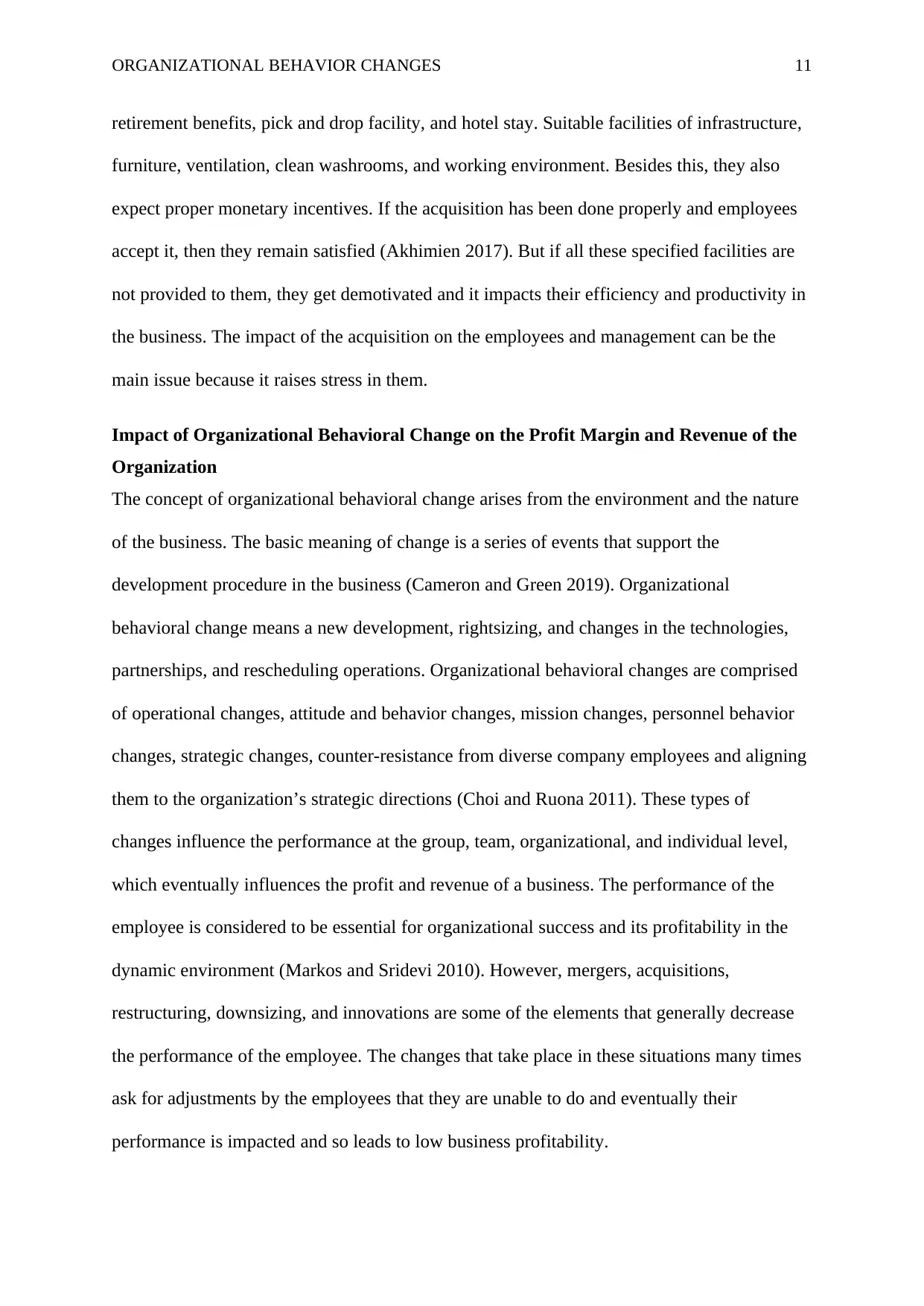
ORGANIZATIONAL BEHAVIOR CHANGES 11
retirement benefits, pick and drop facility, and hotel stay. Suitable facilities of infrastructure,
furniture, ventilation, clean washrooms, and working environment. Besides this, they also
expect proper monetary incentives. If the acquisition has been done properly and employees
accept it, then they remain satisfied (Akhimien 2017). But if all these specified facilities are
not provided to them, they get demotivated and it impacts their efficiency and productivity in
the business. The impact of the acquisition on the employees and management can be the
main issue because it raises stress in them.
Impact of Organizational Behavioral Change on the Profit Margin and Revenue of the
Organization
The concept of organizational behavioral change arises from the environment and the nature
of the business. The basic meaning of change is a series of events that support the
development procedure in the business (Cameron and Green 2019). Organizational
behavioral change means a new development, rightsizing, and changes in the technologies,
partnerships, and rescheduling operations. Organizational behavioral changes are comprised
of operational changes, attitude and behavior changes, mission changes, personnel behavior
changes, strategic changes, counter-resistance from diverse company employees and aligning
them to the organization’s strategic directions (Choi and Ruona 2011). These types of
changes influence the performance at the group, team, organizational, and individual level,
which eventually influences the profit and revenue of a business. The performance of the
employee is considered to be essential for organizational success and its profitability in the
dynamic environment (Markos and Sridevi 2010). However, mergers, acquisitions,
restructuring, downsizing, and innovations are some of the elements that generally decrease
the performance of the employee. The changes that take place in these situations many times
ask for adjustments by the employees that they are unable to do and eventually their
performance is impacted and so leads to low business profitability.
retirement benefits, pick and drop facility, and hotel stay. Suitable facilities of infrastructure,
furniture, ventilation, clean washrooms, and working environment. Besides this, they also
expect proper monetary incentives. If the acquisition has been done properly and employees
accept it, then they remain satisfied (Akhimien 2017). But if all these specified facilities are
not provided to them, they get demotivated and it impacts their efficiency and productivity in
the business. The impact of the acquisition on the employees and management can be the
main issue because it raises stress in them.
Impact of Organizational Behavioral Change on the Profit Margin and Revenue of the
Organization
The concept of organizational behavioral change arises from the environment and the nature
of the business. The basic meaning of change is a series of events that support the
development procedure in the business (Cameron and Green 2019). Organizational
behavioral change means a new development, rightsizing, and changes in the technologies,
partnerships, and rescheduling operations. Organizational behavioral changes are comprised
of operational changes, attitude and behavior changes, mission changes, personnel behavior
changes, strategic changes, counter-resistance from diverse company employees and aligning
them to the organization’s strategic directions (Choi and Ruona 2011). These types of
changes influence the performance at the group, team, organizational, and individual level,
which eventually influences the profit and revenue of a business. The performance of the
employee is considered to be essential for organizational success and its profitability in the
dynamic environment (Markos and Sridevi 2010). However, mergers, acquisitions,
restructuring, downsizing, and innovations are some of the elements that generally decrease
the performance of the employee. The changes that take place in these situations many times
ask for adjustments by the employees that they are unable to do and eventually their
performance is impacted and so leads to low business profitability.
⊘ This is a preview!⊘
Do you want full access?
Subscribe today to unlock all pages.

Trusted by 1+ million students worldwide
1 out of 48
Related Documents
Your All-in-One AI-Powered Toolkit for Academic Success.
+13062052269
info@desklib.com
Available 24*7 on WhatsApp / Email
![[object Object]](/_next/static/media/star-bottom.7253800d.svg)
Unlock your academic potential
Copyright © 2020–2025 A2Z Services. All Rights Reserved. Developed and managed by ZUCOL.





